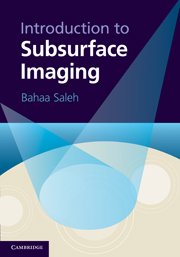Book contents
- Frontmatter
- Contents
- Authors and Contributors
- Preface
- Acknowledgements
- Outline and Roadmap
- 1 Overview
- 2 Physical Models
- 3 Localized Imaging
- 4 Tomographic Imaging
- 5 Digital Image Processing
- 6 Spectral Imaging
- 7 Mosaicing, Change Detection, and Multisensor Imaging
- 8 Numerical Simulation
- 9 Design of Subsurface Imaging Systems
- A Multi-Dimensional Signals and Systems
- B Linear Algebra
- C Detection and Classification
- D Software Tools
- Index
8 - Numerical Simulation
Published online by Cambridge University Press: 05 June 2012
- Frontmatter
- Contents
- Authors and Contributors
- Preface
- Acknowledgements
- Outline and Roadmap
- 1 Overview
- 2 Physical Models
- 3 Localized Imaging
- 4 Tomographic Imaging
- 5 Digital Image Processing
- 6 Spectral Imaging
- 7 Mosaicing, Change Detection, and Multisensor Imaging
- 8 Numerical Simulation
- 9 Design of Subsurface Imaging Systems
- A Multi-Dimensional Signals and Systems
- B Linear Algebra
- C Detection and Classification
- D Software Tools
- Index
Summary
In real-world subsurface imaging it is essential to consider the details of the geometry and properties of the object and the surrounding background. Often, it is sharp edges, small indentations, misalignments, randomly changing features, rough interfaces, volumetric inhomogeneities, or random shape variations that give the scattered waves their particular form, which in turn may provide the features necessary to identify the subsurface target. Examples of realistic subsurface imaging geometries that require numerical modeling to accurately predict the sensed responses (Fig. 8.0-1) include: small distinctly shaped buried objects, such as land mines; objects with fins or cavities, such as an open can; objects with multiple material types, such as rocks underwater with attached coral; background media with distributed inclusions, such as blood vessels in tissue; or large irregularly shaped background regions, such as a layered rock formation; or media with significant frequency-dependent material properties, such as biological tissue.
Real-world problems are therefore difficult to analyze, and exact solutions to the differential equations describing wave propagation in such inhomogeneous environments often do not exist. Numerical methods, the subject of this chapter, are therefore indispensable.
Overview of Numerical Methods
Exact, Approximate, and Numerical Solutions
Before embarking on a solution by numerical simulation, exact analytical solutions and analytical solutions based on appropriate approximations must first be considered. We will develop a progression of decisions to determine the most appropriate method to use for a given subsurface imaging problem: (1) an exact analytical solution, (2) an analytical solution based on some appropriate approximation, or (3) a numerical solution.
- Type
- Chapter
- Information
- Introduction to Subsurface Imaging , pp. 323 - 360Publisher: Cambridge University PressPrint publication year: 2011



